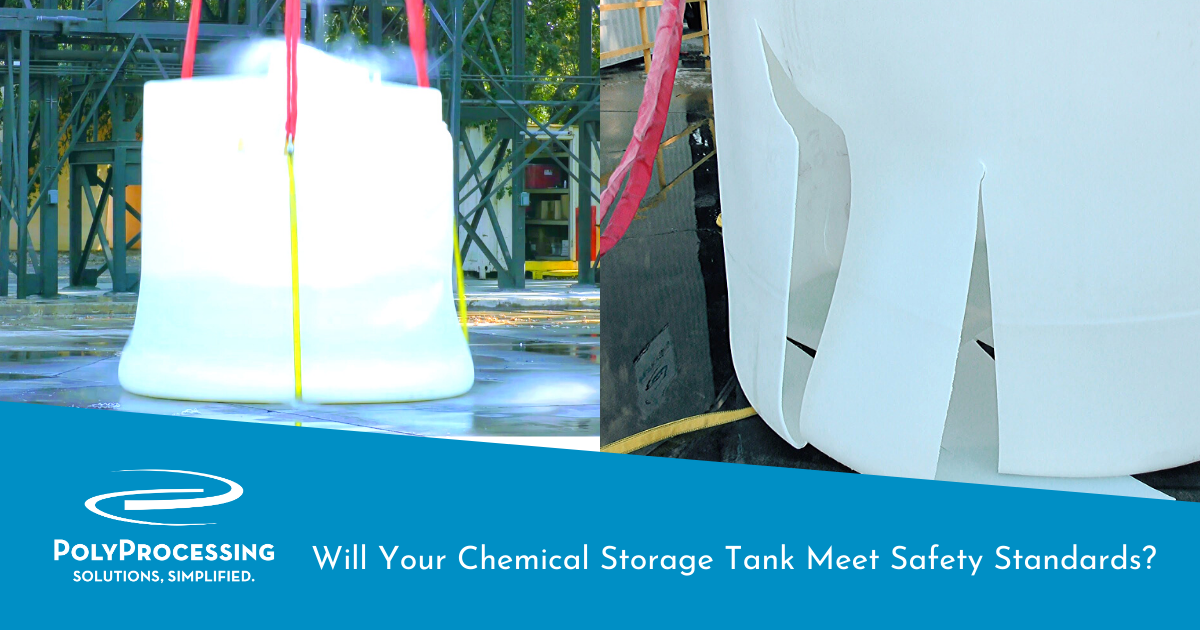Will Your Chemical Storage Tank Meet Safety Standards?
On the surface, polyethylene storage tanks can look pretty similar. It isn’t easy to tell a well-designed and constructed tank from a cheap, inferior tank. Many customers don’t realize that there’s a standard for tank construction based on resin properties and testing. Others simply assume all tank manufacturers follow the ASTM D 1998 standards.

ASTM standards require that all polyethylene tanks and tank materials go through three tests to determine the strength and structural integrity of the chemical storage tank. There is also an additional test for cross-linked polyethylene tanks to measure the chemical makeup of the tank materials. Together, these standardized tests help ensure that you have the strongest, most durable chemical storage tank available.
How Safe Is Your Chemical Storage Tank?
Don’t assume your polyethylene chemical tank manufacturer adheres to the highest standard of safety. Many manufacturers use their own internal standards, which can fall far below the international gold standard. Instead, always verify that your storage tank has been manufactured according to ASTM D 1998 standards.
To determine a PSI rating, resin manufacturers perform tests on compression molded resin samples. Although those tests are adequate for their purposes, the resin samples aren’t rotationally molded—they’re compression molded. Therefore, their standard doesn’t apply to tanks that are rotationally molded, such as Poly Processing’s tanks.
To ensure there’s a proper cushion of safety, ASTM has adjusted the PSI ratings provided by resin producers. This provides a high margin of safety and provides peace of mind that your storage tank can withstand impacts, chemical weight, and pressures under storage.
Here’s what it means in simple terms. When calculating proper wall thickness, the ASTM D 1998 standard requires de-rating the resin’s strength by 50 percent. That means a tank wall that is rated at 1200 PSI must be de-rated to 600 PSI under ASTM D standards. The manufacturer will need to increase the thickness of the tank wall so that the de-rated value is 1200 PSI.
However, if the manufacturer doesn’t apply the ASTM standard to their chemical storage tanks, they could select any hoop stress rating up to 1200 PSI. This explains why two tanks designed to store the same specific gravity rating can vary so greatly and perform so differently.
Get the Facts Before You Buy
The ASTM D 1998 standard uses specific tests to determine how various materials are processed together to form the finished rotational molded product. In polyethylene storage tanks, the mechanical properties of the resins are factored in to accommodate the weight of the material being stored. ASTM has calculated the maximum pounds per square inch of pressure at a real-life level to determine performance numbers.
Before you purchase a polyethylene chemical tank, it’s important to ensure that the manufacturer is meeting ASTM D 1998 manufacturing parameters. Ask to examine the hoop stress tests, learn how stress is actually calculated, and review wall thickness data sheets from the tank manufacturer. They should have these technical documents and data sheets available for your verification so that you can be assured the tank is designed and manufactured to the highest safety standards.
Saving a couple thousand dollars on the upfront cost of a tank could end up costing you tens of thousands of dollars in the event of a catastrophic tank failure. If you don’t know the facts, you won’t know the difference between a well-designed, high-performing tank and a cheap, poorly constructed tank.
Get more detailed information about Poly Processing’s compliance with the ASTM D 1998—download the ASTM D 1998 Technical Bulletin.
For specific questions about ASTM D 1998 or Poly Processing’s manufacturing standards, contact a chemical storage tank expert.
- December 16, 2019
- Topics: Value Added
About Poly Processing
Posts By Topic
Tech Talk Podcast Episodes
Subscribe By Email
Recent Posts
- Installation Tips for Chemical Storage Tanks: Site Preparation and Offloading
- Understanding pH and Chemical Concentration When Choosing a Chemical Tank
- Maximizing Fill Efficiency: Selecting the Optimal Fill Line System
- Chemical Storage Tanks: A Quick Guide for End Users
- Popular Customization Options for Chemical Storage Tanks
Tank Configurator

Find the recommended tank and system components for your chemical storage challenge.
Configure a Tank Package



